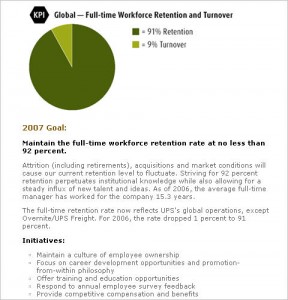“Transparency” has become an echoing buzzword lately, especially in reference to government, politics and corporate affairs.The topic of transparency doesn’t typically trickle down to the corporate Careers site—but it absolutely should.
I started thinking about this while reviewing sites for the diversity series, and wondering whether pictures are showing actual employees, and whether they are accurately suggesting diversity ratios. Then I came across this observation in the very interesting 8th Annual Sources of Hire Study (released February 2009) from Career Xroads:
We are amazed that we have failed to uncover a single firm that transparently shares their internal movement figures on their website to bolster their claims of employee development despite that fact that we regularly review a thousand companies’ staffing pages each year.
I hadn’t actually considered that particular gap. But I have asked myself more than once why I should believe that employee testimonials (even granting that they are honest) actually represent the majority of employee opinion. Wouldn’t it be great to know a little more about employee retention, voluntary turnover, employee survey results, and other factual evidence about employee satisfaction?
So I checked a dozen companies at random from the Fortune 100 Best Places to Work list. It wasn’t a drill-down search, but it was a respectable attempt to find out (spending about as much time as a typical visitor might) whether there was any statistical or quantitative information about employee satisfaction on the site.
And the answer is . . . Nope. The single exception I found in this small sample was the UPS site, where—tucked away in the Social section, discussing the Global Workforce–there actually is a super-simple depiction of retention statistics and a brief discussion of the approach and goals.
Problem: This information is by now three years out of date. And that’s one probable reason why companies don’t put employee statistics on their sites—i.e., they don’t want to be bothered with keeping the information up to date. Still, kudos to UPS for even a rudimentary attempt.
Cisco has information on its site about diversity in new hires, broken out by percentage, and up to date through 2008. So it would seem that zeal for displaying diversity may trump the issue of information maintenance. But Cisco provides no similar information about internal movement (as brought up by Career Xroads) or retention.
And by the way, it’s not that companies think the word “retention” won’t have value, or won’t be understood. Many sites boast that the company has “excellent” (or “outstanding,” “high,” etc.) retention. But since we don’t know what grading system they might be using, these superlatives are not very helpful. Is 70% retention considered excellent? 80%?
In fairness, it’s always a challenge to communicate statistical/factual information clearly and accurately, providing an appropriate context for interpretation. So companies may prefer to say nothing at all, rather than risk creating a false or negative impression. Or they may not have appropriately current and comprehensive information. Or they may not have a good understanding of how the information would be received. Or . . . they may not have favorable statistics.
Realistically, it may just be too much trouble–or it just hasn’t occurred to anyone. After all, as long as no one is offering this type of information, there’s no pressure on anyone to do so. But it definitely seems there might be something to gain from the attempt. Perhaps–a competitive advantage?
Thanks to greeblie for the evocative window photograph.



 I’m a big
I’m a big